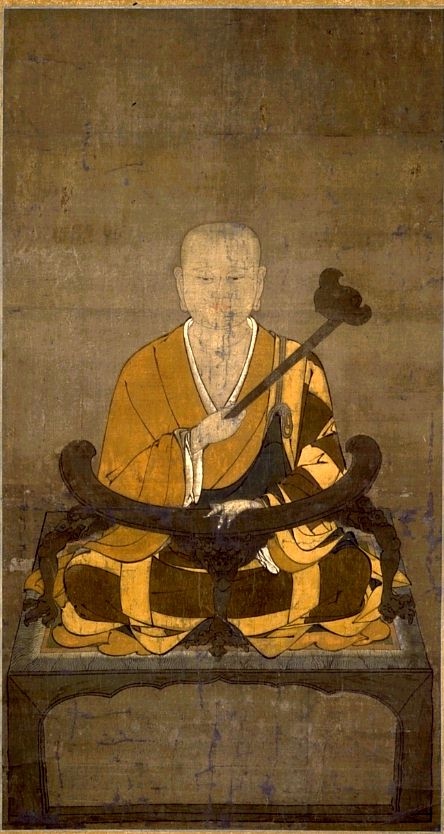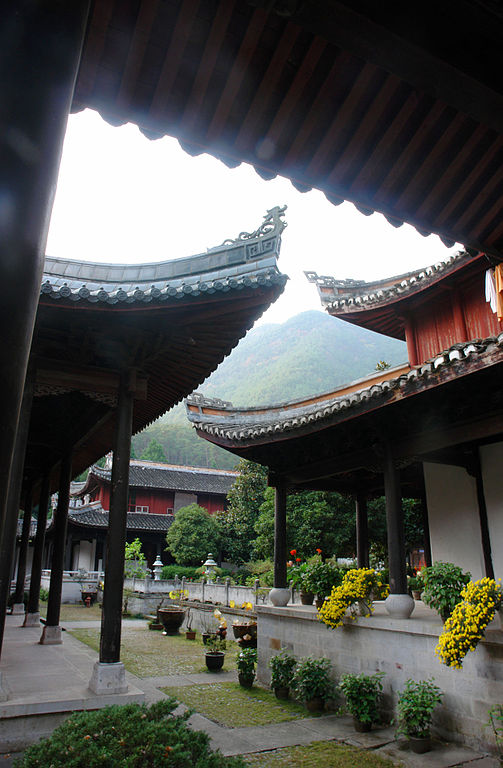
“The progression through the three contemplations of emptiness, conventional existence, and the middle described here is called the ‘sequential threefold contemplation’ … Chi-i defines as superior ‘the contemplation in which all three truths are discerned simultaneously; this is the perfect and immediate calming and contemplation’” (Jacqueline Stone – Original Enlightenment and the Transformation of Medieval Japanese Buddhism)
Zhiyi (Chih-i – 538-597) is the founder of the Tiantai school, which, in the words of scholar Brook Ziporyn was “the earliest attempt at a thoroughgoing Sinitic reworking of the Indian Buddhist tradition.” As it soon became the custom in China, the school simply took its name from that of the mountain where Zhiyi lived and practiced. Buddhist texts had been introduced rather haphazardly into China from India through Central Asia, with some teachings apparently contradicting others, and there was an urgent need to organise them into a coherent system. This was the task Zhiyi set out for himself as a lifetime project. His first move was to place the Lotus Sutra at the centre of his system. Though written in India at the beginning of the first millennium, the Lotus Sutra had not attracted much attention in India – besides criticism -, but, perhaps in part thanks to Zhiyi, it became the most popular Buddhist sutra in China, as well as in Japan, where the Tiantai teachings were imported by Saicho to form the core teaching of the Tendai monastic complex on Mt Hiei.
From a philosophical standpoint, however, Zhiyi’s greatest contribution to East Asian Buddhism has been his doctrine of the Threefold Truth, which is succinctly presented as the addition of a third Truth – the Middle – to Nagarjuna’s Two Truths doctrine – Absolute Truth and Conventional Truth – where this third truth is conceived as an overlap between Nagarjuna’s two truths.
Paul Swanson writes: “A threefold (or fourfold) pattern was identified as the key to basic Buddhist teachings and practice: that all things arise through a confluence of causes and conditions and therefore are empty of substantial being, and yet all phenomena have significance as being temporary or conventionally existent; to realize these two aspects as identical and equally significant is the Middle Way.” To be precise, the fourfold pattern alluded above refers to the addition to the Threefold Truth, of the truth of “conditional co-arising,” which had been a basic tenet of Buddhism since the days of Sakyamuni Buddha.
Nagarjuna had encapsulated his core teaching in the following well-known formula:
“All things that arise through conditioned co-arising, I explain as emptiness. Again, they are conventional designations. Again, this is the meaning of the Middle Path.”
Paul Swanson unpacks the formula as follows: “First is the basic Buddhist insight that all phenomena consist of a confluence of innumerable causes and conditions, that everything is a result of the flux of conditions co-arising (Jap innen or engi; Skt pratitya-samutpada). In other words, there is no unchanging ‘substance’ or ‘self’ within phenomena or at the core of the person. All things are ’empty’ (Jap ku; Skt sunyata) of unchanging or eternal ‘being’, and that is the most fundamental attribute of all of reality (often referred to as ‘thusness’ or ‘suchness’ (Jap shinnyo). Nevertheless, as phenomena arise through the confluence of causes and conditions, they have significance as temporary, conventional, or provisional existence (Jap kemyo) or forms. As they are experienced by us, given conventional designations, and are thus “named,” they ‘exist’ provisionally. Thus, though empty of an eternal and unchanging substance, human beings and other phenomena are significant and worthy of attention and, insofar as they experience suffering, are deserving of compassion. To realize the emptiness of all things and their conventional existence is two different ways of expressing the same truth of conditioned co-arising; this is the wisdom of the ‘Middle Way’ (Jap chudo), the insight of a Buddha.”
Nagarjuna’s formula is most often brought up to define emptiness as dependent origination (here referred to as “conditioned arising”). Emptiness is not a void where nothing at all exists, but the assertion that “dharmas” (things) lack inherent existence, and are not independent of other things. Here, however, the focus on emptiness as ultimate reality has been replaced by a focus on the nature of phenomena as “conventional designations.” In other words, the formula is used to equate “conventional existence” with “conditioned co-arising,” and, as a consequence, with emptiness itself. I would say that here, the question about emptiness is dealt with from the standpoint of phenomena, rather than the standpoint of ultimate reality.
The emphasis on emptiness as ultimate reality in Indian Buddhism had been a reflection of the emphasis on Brahman/Being in the Brahmanical culture. As they rejected Brahman, Indian Buddhist philosophers were led to simply substitute emptiness to Brahman/Being in their philosophical presentations of Buddhism. But in Buddhism, which is an existential approach, rather than an ontological analysis, emptiness is experienced in the context of ordinary lives, as a sense of meaninglessness, rather than as a concept referring to the nature of reality, and Chinese practitioners, free from Brahmanical conditioning, were quick to see that. With Zhiyi and his emphasis on an approach to emptiness from the side of phenomena, a step was taken that was to define Buddhist practice in East Asia.
When uttering the Heart Sutra’s famous formula “form is emptiness,” one is led to see our view of the world as illusory, therefore unreliable, misleading. When the second part of the verse “emptiness is form,” one is invited to see phenomena as the presencing of the ultimate reality of emptiness” in our lives. In Swanson’s words, “What we experience as having ‘form’ – our physical bodies, the chair we sit on, the apple we eat, the rose we smell – is empty of eternal or substantial being since these phenomena are made up of an almost infinite variety of interconnected causes and conditions. And yet ’emptiness’ is not an alternate reality or something apart from the forms we experience in their temporary existence and conventionally named appearances. Emptiness is inseparable from these forms, and the mundane world of temporary forms is where we live and move and have our being.” This, again, is what Nagarjuna refers to as the ‘Middle Way’.
In her book on Original Enlightenment, Jacqueline Stone further explains, taking Zhiyi’s “Mo-ho chih-kuan” as her source:
“First, is ‘entering [the insight of] emptiness from the [viewpoint of] the conventional’ that is, one contemplates the conditioned, dependent nature of all phenomena, which are without permanence or self-essence. From the perspective of this insight, all categories, hierarchies, and boundaries are collapsed; it is a discernment of ultimate equality. The discernment of all phenomena as empty frees one from attachment to desires and intellectual constructs and is said to correspond to the insight of arhats and bodhisattvas of the Tripitaka and shared teachings [between Theravada and Mahayana]. Next is ‘entering [insight into] the conventional from [the discernment of] emptiness’. Having discerned the nonsubstantial, contingent nature of things, one cognizes their provisional existence as phenomena arising through dependent origination and is thus able to act in the world in a soteriologically effective way. This discernment re-establishes categories and distinctions, but without biased attachment or false essentializing; it is said to correspond to the wisdom of bodhisattvas of the separate [Mahayana] teaching. Last is the ‘contemplation of the Middle Way that is the supreme meaning’. Here one contemplates phenomena as both empty and provisionally existing, discerning both aspects simultaneously. This is said to correspond to the wisdom of the Buddha and the perfect teaching. This progression through the three contemplations of emptiness, conventional existence, and the middle described here is called the ‘sequential threefold contemplation’ … Chi-i defines as superior ‘the contemplation in which all three truths are discerned simultaneously; this is the perfect and immediate calming and contemplation’.”
Sources:
Paul L. Swanson – Chapter on Tiantai/Tendai in the “Oxford Handbook of Japanese Philosophy,” ed. Bret W. Davis (2022)
Jacqueline Stone: “Original Enlightenment and the Transformation of Medieval Japanese Buddhism” (1999)

